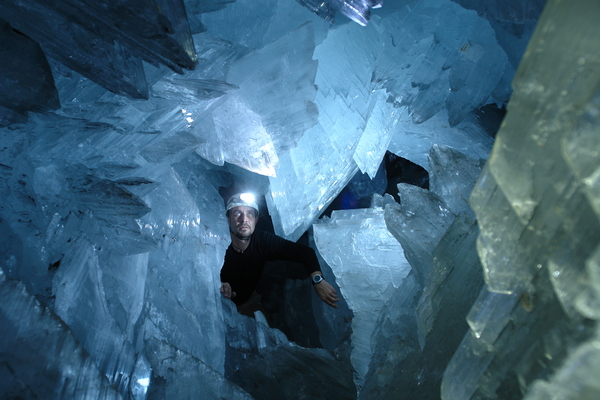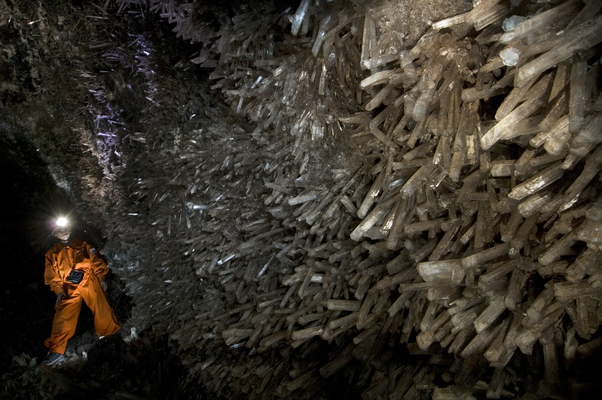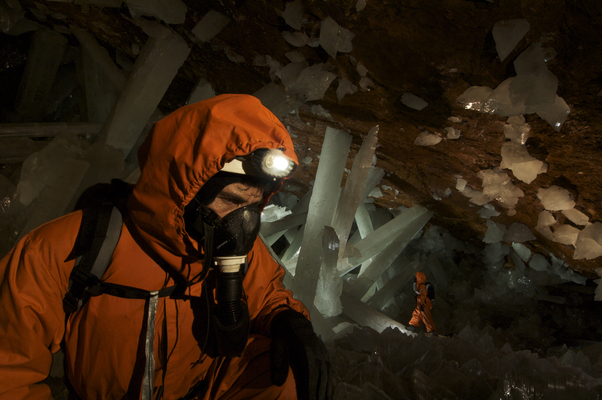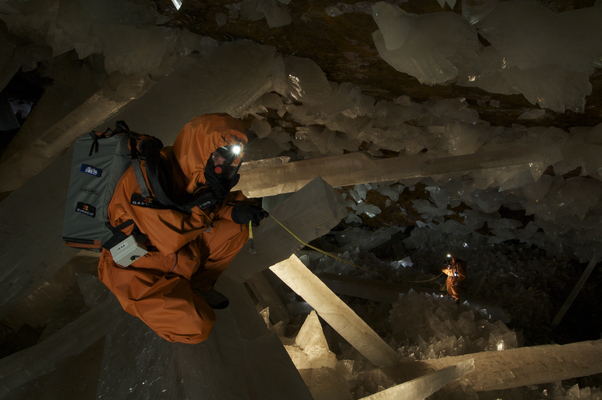
by Carolyn Gramling Thursday, January 5, 2012

National Geographic Channel

National Geographic Channel

Working in the Giant Crystal Cave. National Geographic Channel

National Geographic Channel
Razor-sharp rocks. Deadly crevasses. Unbearable heat. Scalding water. One false step...and you’re history.
“Giant Crystal Cave,” the National Geographic Channel’s hour-long documentary on scientific exploration deep inside Mexico’s Naica Mountain is as much about derring-do and danger as it is about science. The film follows three scientists as they visit the mountain’s most famous cavern for the first time in hopes of unlocking some of its mysteries.
Naica Mountain is a special place, to say the least. Located in the vast Chihuahuan Desert, the mountain sits on a set of fault lines. Superhot metal-rich fluids circulate throughout the mountain, heated by a magma chamber buried two and a half kilometers below. The fluids travel through the mountain's fault lines, depositing veins of lead, zinc and silver ore; since about 1900, miners have delved deep into the mountain to harvest these ore deposits. Because many of the deeper reaches of the mountain are flooded, the mining company Industrias Peñoles operates large pumps to remove water and look for new ores.
In 2000, brothers and miners Juan and Pedro Sanchez were given the go-ahead to excavate a newly dried-out tunnel 300 meters underground. They were drilling into the tunnel when they suddenly found themselves in a magical cavern resembling Superman’s fortress: A massive cathedral-like room filled with towering spurs and spires of gypsum the length of telephone poles.
The brothers didn’t linger long; the temperature in the cavern was deadly. But mine engineers quickly realized that the cavern, dubbed the Crystal Cave of Giants, was a national treasure and sealed it off (which didn’t prevent some people from trying to sneak in and steal crystals; one worker managed to get in but lost consciousness and was later found dead).
Since the discovery, scientists have been fascinated by the gypsum crystals — as much as five times as large as any natural crystals previously discovered. In April 2007, geologist Juan Manuel García-Ruiz of the University of Granada in Spain reported in the journal Geology that the crystals slowly grew over millennia while the cavern was flooded with hot, mineral-saturated water. But there were many more questions to answer.
So in 2007, an international team of scientists visited the cavern, armed with their own questions: When exactly did the crystals begin to grow? And in that extreme environment, is there any life? Lucky for us, National Geographic filmmakers tagged along.
The documentary focuses on three scientists with different goals: Stein-Erik Lauritzen, a geologist at Bergen University in Norway, wants to determine the age of the cave and why so many of the giant crystals have fallen onto the cavern floor; Penny Boston, a geomicrobiologist and astrobiologist at the New Mexico Institute of Mining and Technology in Socorro, is searching for evidence of life that can survive in extreme environments — and perhaps can shed light on the origins of life on Earth; and Chris McKay, a planetary scientist at NASA Ames Research Center, is also searching for evidence of life, with a view to life on other worlds. While Boston will look for direct signs of life — by carving out fluid inclusions within the gypsum crystals that may contain microbial DNA — McKay is armed with a Raman spectrometer, which beams light into the crystals and then analyzes the reflected light for wavelengths characteristic of organic life. If the spectrometer works in this environment, McKay says, a similar instrument may ultimately be bundled onto the next generation of Mars rovers.
All three are ready for adventure. “I grew up wanting to cruise the galaxy and look for weird life forms,” Boston says. “Since I don’t have my own spaceship, I go cruising Earth’s subsurface looking for [them]. And there are a lot of them down there.”
Each of the three researchers enters the cave in turn to study the crystals and collect samples. They register alarm at the intense heat and humidity in the cave, then awe at its beauty. “There are these crystals the size of redwood trees — you stand there with your mouth open,” McKay says. But there was little time for either panic or awe, he adds. As the documentary takes pains to emphasize, the cave is a potential deathtrap: The combination of temperatures hovering around 49 degrees Celsius (120 degrees Fahrenheit) and over-80-percent humidity prevents the body from sweating to cool itself. The minute a person enters the cavern, his body begins to fail. Even in specially-designed protective suits, “we had about half an hour,” McKay says. “You have to focus on what you’re there for.”
That was challenging, Boston says. “Even with the ice-packed suits on, I could feel the strength draining from my arms and legs, and movement growing harder and harder. Besides feeling like I was wading through hot molasses with my brain becoming slower and slower. My temper was unusually short.”
Still, she says, “whatever it takes to work there is worth it. The Naica crystals and the glowing red walls have a transformative beauty that makes the danger meaningless.”
I won’t give away the ending to each researcher’s story — how they determine the cave’s age, why so many crystals fell and whether there are signs of life. For that, and for more of this harrowing tale of scientific exploration in an extreme environment, tune in to “Giant Crystal Cave,” which airs on the National Geographic Channel Sunday at 9 p.m. EDT.
© 2008-2021. All rights reserved. Any copying, redistribution or retransmission of any of the contents of this service without the expressed written permission of the American Geosciences Institute is expressly prohibited. Click here for all copyright requests.